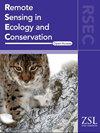昆虫相机陷阱图像的边缘处理
IF 4.3
2区 环境科学与生态学
Q1 ECOLOGY
引用次数: 0
摘要
在所有已知的多细胞物种中,昆虫几乎占了一半,但对它们的了解却落后于大多数脊椎动物物种。部分由于这个原因,它们在生物多样性保护政策和实践中经常被忽视。用于自动监测的计算机视觉工具,如昆虫相机陷阱,有可能彻底改变昆虫的研究和保护。为了进一步推进昆虫相机捕获及其图像数据的分析,需要有效的图像处理管道。在本文中,我们提出了一个灵活和快速的处理管道,旨在通过检测,跟踪和分类夜间昆虫在15个昆虫类的广泛分类和单个蛾种的分辨率来分析这些记录。提出了一种带有异常检测的分类器,用于过滤不确定分类正确的深色、模糊或部分可见的昆虫。提出了一种结合特征嵌入、距离和面积代价的简单逐迹检测算法。我们评估了不同边缘计算设备(树莓派和NVIDIA Jetson Nano)的计算速度和功耗性能,并比较了不同的延时(TL)跟踪策略。与0.5帧/秒的跟踪相比,2分钟TL间隔的检测差异最小;然而,对于每晚检测不到一次的昆虫,Pearson相关性降低。从跟踪转向TL监控将减少记录图像的数量,并允许在树莓派的相机陷阱上实时处理图像的边缘。Jetson Nano是最节能的解决方案,能够以近0.5 fps的速度实时跟踪。我们的处理流程应用于超过570万张图像,以每秒0.5帧的速度从12个轻型相机陷阱中记录下来,在两个完整的季节中位于不同的栖息地,包括沼泽,荒原和森林。因此,我们的结果显示了昆虫相机陷阱的可扩展性。本文章由计算机程序翻译,如有差异,请以英文原文为准。
Towards edge processing of images from insect camera traps
Insects represent nearly half of all known multicellular species, but knowledge about them lags behind for most vertebrate species. In part for this reason, they are often neglected in biodiversity conservation policies and practice. Computer vision tools, such as insect camera traps, for automated monitoring have the potential to revolutionize insect study and conservation. To further advance insect camera trapping and the analysis of their image data, effective image processing pipelines are needed. In this paper, we present a flexible and fast processing pipeline designed to analyse these recordings by detecting, tracking and classifying nocturnal insects in a broad taxonomy of 15 insect classes and resolution of individual moth species. A classifier with anomaly detection is proposed to filter dark, blurred or partially visible insects that will be uncertain to classify correctly. A simple track‐by‐detection algorithm is proposed to track classified insects by incorporating feature embeddings, distance and area cost. We evaluated the computational speed and power performance of different edge computing devices (Raspberry Pi's and NVIDIA Jetson Nano) and compared various time‐lapse (TL) strategies with tracking. The minimum difference of detections was found for 2‐min TL intervals compared to tracking with 0.5 frames per second; however, for insects with fewer than one detection per night, the Pearson correlation decreases. Shifting from tracking to TL monitoring would reduce the number of recorded images and would allow for edge processing of images in real‐time on a camera trap with Raspberry Pi. The Jetson Nano is the most energy‐efficient solution, capable of real‐time tracking at nearly 0.5 fps. Our processing pipeline was applied to more than 5.7 million images recorded at 0.5 frames per second from 12 light camera traps during two full seasons located in diverse habitats, including bogs, heaths and forests. Our results thus show the scalability of insect camera traps.
求助全文
通过发布文献求助,成功后即可免费获取论文全文。
去求助
来源期刊

Remote Sensing in Ecology and Conservation
Earth and Planetary Sciences-Computers in Earth Sciences
CiteScore
9.80
自引率
5.50%
发文量
69
审稿时长
18 weeks
期刊介绍:
emote Sensing in Ecology and Conservation provides a forum for rapid, peer-reviewed publication of novel, multidisciplinary research at the interface between remote sensing science and ecology and conservation. The journal prioritizes findings that advance the scientific basis of ecology and conservation, promoting the development of remote-sensing based methods relevant to the management of land use and biological systems at all levels, from populations and species to ecosystems and biomes. The journal defines remote sensing in its broadest sense, including data acquisition by hand-held and fixed ground-based sensors, such as camera traps and acoustic recorders, and sensors on airplanes and satellites. The intended journal’s audience includes ecologists, conservation scientists, policy makers, managers of terrestrial and aquatic systems, remote sensing scientists, and students.
Remote Sensing in Ecology and Conservation is a fully open access journal from Wiley and the Zoological Society of London. Remote sensing has enormous potential as to provide information on the state of, and pressures on, biological diversity and ecosystem services, at multiple spatial and temporal scales. This new publication provides a forum for multidisciplinary research in remote sensing science, ecological research and conservation science.
 求助内容:
求助内容: 应助结果提醒方式:
应助结果提醒方式:


